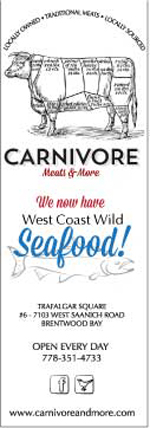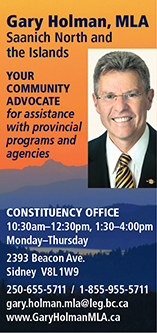Archive for May 2015
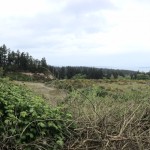
Major Housing Development Planned For Cordova Bay
by Roger Stonebanks, citizen journalist
The first draft of plans for residential development of the former Trio property in Cordova Bay show a mix of housing types with 440 dwelling units including a 12-storey condo.
Aragon Properties disclosed its initial development thoughts to more than 100 people who attended a public input meeting on May 30, 2015, following an earlier input meeting in February. David Roppel ([email protected]), the company’s director of planning and development, said Aragon Properties is “open” to a third meeting if requested. Otherwise, he said the next step is to consider public input, formulate revisions and submit a rezoning application to Saanich for the 26-acre property.
The property is currently zoned into three roughly equal parts but only one part (where Gravel Mart used to be) has residential zoning for condos and townhouses to a maximum 110 dwelling units and a six-storey height limit. Roppel said Aragon Properties plans to develop the entire property for residences.
The initial plans show the property divided into three terraces with row houses and single-family houses and high-rises ranging from “low” at two to five storeys, “mid” at six possibly eight storeys and “high” which “could be 10 to 12 storeys,” said Franc D’Ambrosio, project architect who was also the architect for nearby Mattick’s Farm, Mattick’s Green, Mattick’s Wood and the early stages of Sayward Hill residential development.
There could also be a commercial component of offices and retail.
“Community consultation is essential,” D’Ambrosio told the meting. “You have to be included in the planning.”
Roppel said he received 90 slips of paper with comments at the meeting plus comments written on large sheets of paper. It was clear from the comments that the principal concerns of those attending were the density of development (too much), the height of the 12-storey condo (too much) – and the amount of traffic that will be generated and its impact on Cordova Bay Road.
Mitchell Jacobson of Boulevard Transportation Group in Langford said traffic impacts can be quantified once the number of dwelling units and types of accommodation are settled. He was “looking at” the idea of a roundabout at Cordova Bay Road/Fowler Road. Vehicular access to the property will be from Cordova Bay Road.
Roppel said Aragon Properties foresees a diversity of housing in terms of different housing forms, connectivity to open spaces, fitting into the neighbourhood and any commercial use “must build on the success of Mattick’s Farm and not detract from it.” The single-family and row houses would be fee simple ownership and the rest would be strata or rental. Typically, he said, Aragon allocates 10 per cent rental in developments.
He noted the negative comments about the height and location of the 12-storey condo. The meeting heard that adjacent Sayward Hill has an eight-storey building approved but not yet built on Hill Rise Terrace off Cordova Bay Road. The condos behind Mattick’s Farm adjacent to Cordova Bay Golf Course were originally planned for eight storeys but after negative comments, they were divided into the present two four-storey buildings.
He said the company plans to have a website running in a few weeks.
Looking ahead, he estimated it would take up to a year to get rezoning approval from Saanich with the first Development Permit six to eight months after that. “Hopefully we will complete the project in five to eight years,” he said.
""
While the company initially called the proposed development “Triangle Hill,” it has dropped this name because of negative comments. Until a new name is decided, it will be called “755 Cordova Bay Road’ which is its address.
Please see earlier story on – Engaging the Community Early, and Often.
-30-
BC Liberal appointee or Defender of Local Food Systems?
 by Michele Murphy
by Michele Murphy
Defeated Saanich Mayor Frank Leonard has landed an appointment as the new chair of the Agricultural Land Commission (ALC).
Leonard’s appointment comes on the heals of the controversial firing of Richard Bullock as the Agricultural Land Commission board chair and CEO with seven months left to go on his contract.
Leonard will take up duties at the ALC immediately combining duties as board chair and CEO for a period of five months while he leads the search for a new CEO of the commission.
Bullock has been a vocal critic of recent changes to the ALC act. The changes saw the creation of regional boards, as well as separating the province’s ALR land into two separate zones opening up non-agricultural use of farmland for over 90% of the province’s ALR farmland.
Bullock has most recently been on the offensive as concerns are being raised about the province’s farmland being bought up by foreign companies to grow forests for carbon credits. These carbon sinks include imposing a restrictive 100-year covenant on the ALR land.
Lana Popham, Saanich South MLA and Opposition Critic for agriculture, said of Bullock’s firing, “Bullock is a true champion for agriculture, who is respected by all sectors of the agriculture industry for his expertise and fair-mindedness.”
While Saanich has a rich history of farming with almost 20% of the municipality located within the ALR, Leonard’s background and interests show no obvious connection to the agriculture. The long-time municipal politician comes from a background of managing several family-owned tires stores. While in business, Leonard served as a director of the BC Chamber of Commerce, president of the Victoria Chamber of Commerce, and on the boards of local tourism and economic development groups and served as a director of the BC Investment Management Corporation.
While in public office, Leonard chaired the Municipal Finance Authority of BC, was president of the Union of BC Municipalities and a director of the Federation of Canadian Municipalities. He has also chaired the Capital Regional District, the Hospital District, the region’s Housing Corporation, the Saanich Police Board, and has served on the Regional Transit Commission. He has also served on numerous recreation, arts, and community boards.
Leonard was past co-chair of the Farm Assessment Review Panel, which looked at the farm classification process and regulations for municipal tax purposes.
In contrast, Bullock’s background includes serving as president of the BC Fruit Growers’ Association, BC Tree Fruits Ltd., and Sun-Rype Products Ltd., and as Director of the Canadian Federation of Agriculture. According to the ALC website Bullock has extensive experience in international consulting including the production and processing of agricultural crops. He is a former member of the BC Marketing Board and the past Chair of the BC Farm Industry Review Board. And now, past chair and CEO of the BC Agricultural Land Commission.
""
“This is a critical time for B.C. agriculture, as the Liberals prepare to release new regulations stemming from Bill 24, which weakened farmland protections on 90 per cent of ALR land. By replacing B.C.’s agricultural watchdog with someone with no background in agriculture, the B.C. Liberals are making it clear that their attack on the ALR has only just begun,” adds Popham.
Time will tell if Leonard’s skills in business are transferable to preserving agricultural land and encouraging farming in British Columbia.
-30-
Check out Peninsula Video’s coverage of Richard Bullock providing some insights for local agrologists on the affairs of the ALC in BC HERE
Amalgamation Study to Hit Saanich Council
by Roger Stonebanks, citizen journalist

Saanich Councillor Colin Plant
The issue of a provincial government-funded study of amalgamation/governance on southern Vancouver Island will hit Saanich council at its next meeting on May 25.
Coun. Colin Plant tabled a notice of motion “regarding provincially-funded amalgamation study” at council on Monday night (May 11, 2015). Coun. Fred Haynes has agreed to second Plant’s motion when it reaches council.
Plant’s motion calls on council to “write a letter to (Community) Minister Coralee Oakes indicating our willingness to participate in the study.” The letter will be developed by Mayor and Council with the assistance of staff.
“Prior to drafting the letter, residents will be invited to a public meeting to provide feedback for Mayor and Council as to what should be included in our letter.”
Plant’s motion states that the BC government “has agreed to do an amalgamation study for interested municipalities in the Capital Regional District” and that Saanich residents voted in favour of a “governance review.”

Saanich Councillor Fred Haynes
Last November, Saanich residents were polled in a question that specifically avoided the word “amalgamation.” It asked: “Do you support Council initiating a community-based review of the governance structure and policies within Saanich and our partnerships within the Region?” It passed 21,437 votes to 2,780 votes. There were 80,986 eligible voters.
Minister Oakes, in her most recent comment to Saanich Voice Online on April 24, 2015, also avoided using the word “amalgamation” in favour of “governance and service integration.”
She said: “The Ministry of Community, Sport and Cultural Development is in the process of considering how best to proceed regarding the results of the referenda in the Capital Region.
“The Ministry sees an opportunity to support a conversation on governance and service integration and has heard from some Mayors and Councils but needs to hear from others to gauge interest and better understand how to collaborate on this goal.
“Decisions about potential next steps will come out of the Province’s considerations and future discussions between local governments and the provincial government.”
Last December, Saanich council voted unanimously “That a governance review, in accordance

BC Minister of Community, Sport and Cultural Development, Coralee Oakes
with the motion on the ballot, be initiated as soon as possible, within a 90-day period.” Council also requested municipal staff “to
prepare a report, as soon as possible within a 90-day period, indicating how such a review might be structured and carried out in accordance with the motion on the ballot.”
Council is awaiting the staff report on the Saanich governance review.
Coun. Colin Plant told SVO, “The intent behind my motion is to take advantage of the fact the province is willing to fund an amalgamation study. It is not to determine Saanich’s own governance review. I fully support the municipality continuing to develop its own governance review as per our Nov. 15 plebiscite. It just seemed like common sense to me that we would participate given that there is no binding component to the study.
“Given that the report will be non-binding and at no direct cost to Saanich, I see no harm in us contributing information and learning from the study. I liken this to getting a quote from a business; just because one gets a quote, it doesn’t mean you have to act on it.
“The motion also requires council to have a public meeting where residents can tell council what they think should be in the letter we send to the province indicating our interest in participating in the study. The reason for this public meeting is that unlike other municipalities who put an amalgamation question on the ballot, Saanich did not. As such, I think the public should be afforded an opportunity to provide feedback before the municipality sends any comments to the province.
“I look forward to residents providing feedback to council on May 25.”
Coun. Fred Haynes replied to SVO, “Amalgamation study? What does it mean for Saanich? I look forward to hearing from the public on May 25 (in the new public participation format at start of council meetings) and our following discussion at council to explore the benefits of the information to be gained by the province-led study. I understand this study will examine options for service integration and the potentials possible from reorganization of our regional government – this includes a better understanding of our cost effectiveness and service efficiencies at the CRD and between and within our municipalities. This study would be in addition to our own community-based review of the governance structure and policies within Saanich and partnerships within the region. Presumably, joining the regional conversation (study) would let Saanich residents and council have some say in its format and the type of information collected and reviewed. Let’s find out.”
For earlier information and comments about amalgamation on the Saanich Peninsula and in Greater Victoria, please see:
Amalgamation Study for the Peninsula? April 23, 2015
Regional Collaboration – a work in progress March, 2015
Comment is Free, But Facts are Sacred April, 2015
Moving Amalgamation Forward, or Not January, 2015
Amalgamation – where do we go from here? December, 2014
-30-
Stalking the White Robin
A rare glimpse of the white robin on the Peninsula
photo and story by Ed Johnson
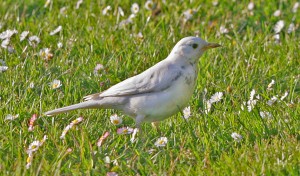 Imagine my surprise when friends called me up to tell me about a white robin they had seen on the peninsula. At first they thought it must be a dove, but on closer examination it became evident that this was the rare partial albino form of the North American robin.
Imagine my surprise when friends called me up to tell me about a white robin they had seen on the peninsula. At first they thought it must be a dove, but on closer examination it became evident that this was the rare partial albino form of the North American robin.
Before heading out with a camera, a brief research was in order.
Not being a full albino which would be even rarer, the partial albino has pigment in its eyes rather than the pink colour which eventually renders the animal blind with a shorter lifespan than the usual 11 or more years. In fact, it appears, the partial albino robin is the predominate form, but both forms are only found in one in 30,000 robins. While other birds, and indeed some animals, exhibit forms of albinism, as a common yard bird, the robin is the most reported species of bird. In Native American mythology, the robin is known as the ‘can-do’ bird for its industrious nature. Its caring parental nature is considered by some as good luck for a pregnant woman to see robins feeding their young. Others saw them as a symbol of peace.
Birds lacking pigmentation are becoming a more usual sight on Vancouver Island. Well known Nanoose photographer, Mike Yip, has photographed white ravens in Qualicum over the past six years. These blue eyed birds are also partial albinos or more correctly described as leucistic, a reduction of all types of pigmentation rather than just melanin.
And now we have our own local celebrity. Knowing that robins prefer earthworms – I had fed a mother robin and her brood one spring by placing a pile of worms on a dirt pile and watching her snatch them up and fly off to her nest – I knew a bit about habitat and where to look for this particular robin. But, of course, the first time out is never lucky and all I found in the area were the normal red breasted variety.
Considering it to be a warm day and not conducive to mid day worm gathering, I decided that near evening would be both cooler and perhaps more of a stimulant to the appetite.
That hunch proved prescient. As I approached the area where this bird is usually seen, I immediately spotted her on the lawn. The picture here is my effort to get as close as possible with a 180mm lens before she took flight. Maybe I will pack a few worms next time!

Engaging the Community Early, and Often
Developer of former Trio site says they are looking for input
by Roger Stonebanks, citizen journalist
The owner of one of the last significant developable properties within the Urban Containment Boundary in Saanich, the 26-acre former Trio site in Cordova Bay, is asking the community first – what do you want? – before coming up with and presenting a plan.
It is becoming less so (but it still happens) that property developers come up with plans first and then go to the community to present them. This procedure puts the community in the position of having to be reactive rather than being able to be pro-active – expressing their views before the plan is developed.
“We prefer to engage the community we work in early and often,” David Roppel, Director of Planning and Development for Aragon Properties of Vancouver, told Saanich Voice Online.
“We are interested in what the community’s needs and expectations are. We don’t find the present-and-defend approach successful. We prefer to get community input early and have it inform and support the planning process.”
Aragon Properties held its first community workshop in Cordova Bay on Feb. 21 and more than 100 people attended. A second community input meeting is expected in May.
“We learned the community has a desire for affordable housing in the neighbourhood so adult children of current residents can afford to live here,” said Roppel of the first workshop
“We also learned the neighbours expect a well-considered approach to inter-connected open space. Community members thought it important that the new community fit well with the existing community and build on, not draw away from, Mattick’s Farm.”
Anthony Minniti, president of the Cordova Bay Association for Community Affairs, told SVO that “many more developers are approaching projects” the way Aragon is. His executive has not discussed Aragon’s process in particular but speaking personally, “I applaud the developer for the community consultation process.”
The CBA has had an introductory meeting with Aragon Properties.
John Schmuck, chair of the Saanich Community Association Network, said his association, Quadra-Cedar Hill, likes proponents “to come to us for discussion before they develop their hard plans. This allows us to provide input and get some of our ideas into the original plans. We generally meet with them at the beginning of the process.”
Schmuck said Quadra-Cedar Hill helps proponents hold a meeting with neighbours and other interested persons “who want to have a say in the project. After that is complete we then write our letter to Saanich Planning stating our position on the project before the planners write their report to council.”
Other community associations in Saanich follow a similar procedure. It is Saanich policy to encourage developers to meet and work with community associations.
The former Trio site is at the corner of Cordova Bay Road and Fowler Road and below Alderley Road. For many years it was a gravel quarry and, along with rock crushing, it also had a concrete-making facility. More recently, after those uses ceased, Trio Gravel Mart sold soil mix and mulch and concrete products. The property was sold by the McLaren family to Aragon Properties for $6.1 million last year.
The property, which is within the Sewer Service Area, is being called Triangle Hill by Aragon Properties. It is across Cordova Bay Road from the 37-acre Sayward Hill condos, townhouses and nine-hole golf course that were developed by the Jawl family of Cordova Bay, owner of Mattick’s Farm and the 18-hole Cordova Bay Golf Course. The Triangle Hill architect is Franc D’Ambrosio. With his former partnership, deHoog D’Ambrosio, he was master planner for Mattick’s Farm and Sayward Hill. That firm was architect for Mattick’s Farm, Mattick’s Green and Mattick’s Wood and Phase One of Sayward Hill (the masterplan, rezoning and design guidelines, a six-storey condo and five townhouses). DeHoog proceeded with remaining phases of Sayward Hill after D’Ambrosio formed his own company, D’Ambrosio Architecture and Urbanism in 2003.
While the site was rezoned in 1999 into three areas in anticipation of development, it did not happen. The southeast corner, for example, is zoned for townhouses and condos with a six-storey height limit and a maximum 110 dwelling units. But Roppel says Aragon is restarting the planning process. He said it is too early to determine uses and densities but he appeared to drop one hint when asked about the 9.7-acre mini-storage zone for recreational vehicles in the north part of the property – “Aragon has not built mini-storage in the past.”
Roppel said he welcomes public input and he can be reached at [email protected]
-30-

Marvelling at the Options
A look at Camosun’s Comics & Graphic Novels program
by Judy Barlow, photos by Ken Steacy © 2015
Comics. They’re not just for kids. They’re not always comical. They can entertain, educate, and inspire They’re serious business.
Just ask industry experts Ken and Joan Steacy and the students in the Comics and Graphic Novels Program at Camosun College.
“Visual storytelling is a language comprised of words and pictures working together, inextricably linked. These are not just illustrated stories; it’s a whole new language,” says Ken, adding, “I’ve spent forty years playing in other people’s sand boxes. I’ve worked for Marvel and DC comics and done film – Astro Boy, Iron Man, Star Wars – you name it. And when you’re in the business you spend a lot of time at conventions asking people, ‘Where did you go to school?’ There was really no answer. So Joan and I put together the dream program, if we were young people wanting to learn the language of visual storytelling.”
What they came up with after some tweaking is an intense eight month program (“Kind of a boot camp”, says Joan.) with six visual art and four creative writing courses.
“There’s room for everybody,” says Joan. “There’s no age or gender barrier… A lot of our students are female – quite a departure from Ken’s early experience in a male-dominated industry.”
The program has attracted a host of unique and sometimes weirdly interesting students who view life through a lens that Joe Average can’t imagine. With varied backgrounds and wide-ranging experience, there’s a sense of belonging within this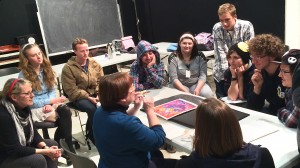 creative cocoon.
creative cocoon.
After ten years in Vancouver, picking up illustration work, and distributing self-published ‘zines of his work, Jesse Blanchard wondered if this program had anything to offer him.
“At first I really scoffed at it,” says Jesse. “I wasn’t prepared to go to post-secondary, but I sent Ken my portfolio and he was very excited to have me, so I moved over here from Vancouver.”
The program has helped him grow as an artist.
“It’s very different coming to an environment where we have instructors telling us what we’re doing right or wrong,” says Jesse, “and we have our peers’ support and critiques. It expedites the learning process and my
development just being around everyone else.”
Evelyna Torttier loves turning her stories into visuals. “It’s fun to actually make the visual that you were seeing in your head as you were writing the story,” says Evelyna. “Anyone that’s really into telling stories and drawing – comics is definitely the way to go.”
Luc Chiasson had tried painting, and drawing, and even scriptwriting – but never forgot that he had always loved creating comics. “It never mattered whether they were good or not,” says Luc. “It was just fun to create this world and live in it with my friends.”
For Luc the best part of the program has been the people.
“It’s nice to know that there are other people that have a separate world from this one,” says Luc. “I love comics better than any other art form. You can create –get past that barrier between us and pictures. You can bring your audience into the story, make them feel things; anger, happiness, sadness – just feel.”
 Luc cautions upcoming artists, “If you’re coming to this program, prepare to work your ass off. Because if you go into anything half-hearted, you’re going to get torn apart. It’s work – you’ve gotta be prepared. Even God took seven days to make the world, so if you’re trying to make a world that people can accept it’s going to take a lot more than seven days.”
Luc cautions upcoming artists, “If you’re coming to this program, prepare to work your ass off. Because if you go into anything half-hearted, you’re going to get torn apart. It’s work – you’ve gotta be prepared. Even God took seven days to make the world, so if you’re trying to make a world that people can accept it’s going to take a lot more than seven days.”
Former UVic student Liz Sakowsky needed a creative outlet. Camosun’s Comics and Graphic Novels program seemed like a pretty good fit – practical and cartoony, with a strong writing and storytelling aspect. The program is fun for Liz. She agrees that it’s all about the people. “The best part is meeting a lot of people who have similar interests,” says Liz; “We’re a tight-knit group; a kind of community.” Liz too has advice for would-be artists.
“If you’re thinking about getting into comics but you don’t think you’re a good enough artist – you are. If you’re thinking about taking the program and you’re hesitant, just go for it. There’s people of all levels here, and there’s so much support and so much learning that can be done. You’ll amaze yourself.”
In today’s visually-oriented world the illustrator wields tremendous power. So to the graduate students venturing out into life and careers after college – use it well.
Bonne chance. “Vous êtes Charlie”.
Characters © 2015 by their creators: Anya Alldritt, Hanan Alyousif, Kailyn Barlow, Jesse Blanchard, Katherine Crane, Georgia Hewitt, Raphael Pirenne, Kay Prosser, Richard Quay, Megan Rowe, Liz Sakowsky, Evelyna Trottier, Luc Chiasson




